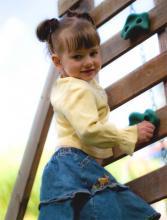
Climbing is an activity that children enjoy from an early age. Most children find climbing fun and strive to accomplish reaching the highest point possible to view the world around them. Exploration is an important part of climbing, whether they are climbing a tree or scaling a rock wall. They climb for excitement and the feeling of achievement when they overcome challenges, test their abilities, and show off for others. Peer pressure and encouragement from others often motivates children to climb structures and accept challenges. Children are also found playing on climbing structures as they engage in dramatic play and chase games.1
As babies begin to crawl and explore their world, they are soon able to pull themselves up on edges of furniture and climb over low obstacles. As their walking develops, they fearlessly attempt more climbing not seeing any danger. Until the age of 4, boys and girls show the same ability in their climbing skills, however, after this age, boys develop more strength than girls. By the age of 6, most children can perform the basic motor skill tasks required for climbing on the level of an adult. By the age of 9 or 10, children become more aware of height and may develop a fear of heights. They also often start to play more sports games by the age of 10 and climb less, although climbing rock walls remains a popular activity for older children.2
Children who are good climbers tend to be lightly built and are strong. They move in a relaxed, easy manner looking around and concentrating on several things at the same time while climbing. They take alternating steps and easily choose the best technique for each object.3 The motor skills of climbers are developed much quicker than non-climbers. In fact, practice in climbing on challenging climbers is a better predictor of skills than the size or age of a child.4
When climbing, children draw on a combination of cognitive skills, such as memory, visualization, and problem solving. They also have physical requirements that involve body, spatial and directional awareness as well as physical abilities, such as power, agility, speed, balance, and coordination. Good visual perception is required to effectively determine foot and hand holds, also known as affordances, when climbing. The development of their perception of affordances results in a number of factors, including leg strength, limb lengths, locomotor abilities, and experience in climbing. As children have more experience in climbing, they will be better at perceiving distances and their reaching capacities. Children who have difficulty climbing may lack good fitness, be overweight, or have a physical disability.5
Besides climbing natural challenges, such as trees, rocks, and hills, today’s playgrounds offer lots of new, innovative climbing structures. The jungle gym from the past is now upstaged by sophisticated climbing frames, rope networks, rock climbing walls, and irregular shaped objects.6Interesting ladders to platforms have been added to playground equipment that make climbing more challenging.
- 1. Frost, Joe L., Pei-San Brown, John A. Sutterby, Candra D. Thornton. The Developmental Benefits of Playgrounds Olney, MD: Association for Childhood Education International, 2004. pp. 55, 126-127.
- 2. Van Herrewegen, Jenny, Johan Molenbroek, and Hedy Goossens. “Children’s Climbing Skills.” ANEC. < http://www.anec.org/attachments/r&t007-04.pdf > 21 Oct. 2010.
- 3. Ibid.
- 4. Frost, Joe L., Pei-San Brown, John A. Sutterby. “Climbing Behavior: The Nature and Benefits of Children’s Climbing Behaviors.” PlayCore. < http://www.playcore.com/upload/file/frost-climbing-final.pdf > 21 Oct. 2010.
- 5. Op. cit., Frost. pp. 127-131
- 6. Op. cit., Van Herrewegen, Molenbroek, and Goossens.

